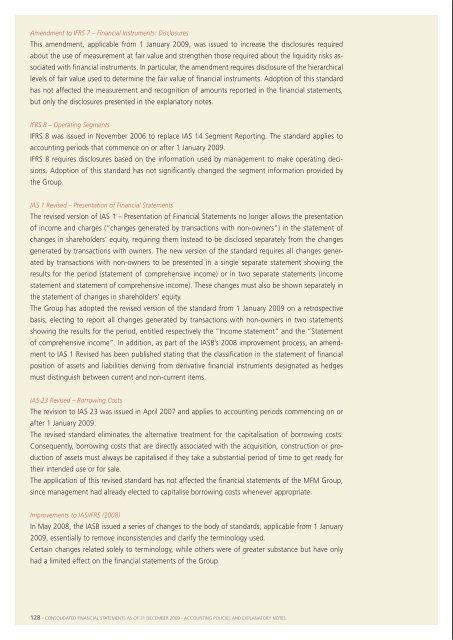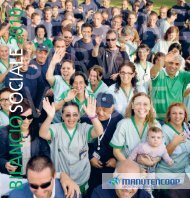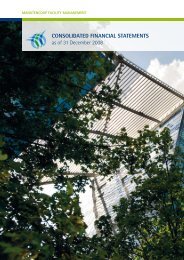Financial Statements 2009 - Manutencoop
Financial Statements 2009 - Manutencoop
Financial Statements 2009 - Manutencoop
Create successful ePaper yourself
Turn your PDF publications into a flip-book with our unique Google optimized e-Paper software.
Amendment to IFRS 7 – <strong>Financial</strong> Instruments: DisclosuresThis amendment, applicable from 1 January <strong>2009</strong>, was issued to increase the disclosures requiredabout the use of measurement at fair value and strengthen those required about the liquidity risks associatedwith financial instruments. In particular, the amendment requires disclosure of the hierarchicallevels of fair value used to determine the fair value of financial instruments. Adoption of this standardhas not affected the measurement and recognition of amounts reported in the financial statements,but only the disclosures presented in the explanatory notes.The following accounting standards, amendments and interpretations, effective from 1 January<strong>2009</strong>, govern circumstances and cases not relevant to the Group at the reporting date, but whichmight have an accounting effect in relation to future transactions or agreements.Amendment to IFRS 2 – Share-based payment: vesting conditions and cancellationsThe amendment to IFRS 2 envisages changes in the conditions for vesting and with regard to cancellations.IFRS 8 – Operating SegmentsIFRS 8 was issued in November 2006 to replace IAS 14 Segment Reporting. The standard applies toaccounting periods that commence on or after 1 January <strong>2009</strong>.IFRS 8 requires disclosures based on the information used by management to make operating decisions.Adoption of this standard has not significantly changed the segment information provided bythe Group.IAS 1 Revised – Presentation of <strong>Financial</strong> <strong>Statements</strong>The revised version of IAS 1 – Presentation of <strong>Financial</strong> <strong>Statements</strong> no longer allows the presentationof income and charges (“changes generated by transactions with non-owners”) in the statement ofchanges in shareholders’ equity, requiring them instead to be disclosed separately from the changesgenerated by transactions with owners. The new version of the standard requires all changes generatedby transactions with non-owners to be presented in a single separate statement showing theresults for the period (statement of comprehensive income) or in two separate statements (incomestatement and statement of comprehensive income). These changes must also be shown separately inthe statement of changes in shareholders’ equity.The Group has adopted the revised version of the standard from 1 January <strong>2009</strong> on a retrospectivebasis, electing to report all changes generated by transactions with non-owners in two statementsshowing the results for the period, entitled respectively the “Income statement” and the “Statementof comprehensive income”. In addition, as part of the IASB’s 2008 improvement process, an amendmentto IAS 1 Revised has been published stating that the classification in the statement of financialposition of assets and liabilities deriving from derivative financial instruments designated as hedgesmust distinguish between current and non-current items.Amendment to IAS 32 – <strong>Financial</strong> Instruments: Presentation and IAS 1 – Presentation of <strong>Financial</strong> <strong>Statements</strong>Puttable instruments and obligations arising on liquidation. This standard requires puttable financialinstruments and financial instruments that oblige an entity to deliver an interest in its activitiesto a third party to be classified as equity instruments.IFRIC 9 – Reassessment of Embedded Derivatives and IAS 39 <strong>Financial</strong> Instruments: Recognition andMeasurementThe changes to IFRIC 9 and IAS 39 were issued in March <strong>2009</strong> and apply to accounting periodsending on or after 30 June <strong>2009</strong>. The changes require an entity to determine if an embedded derivativemust be separated from the host contract when it reclassifies a hybrid financial instrumentaway from the “fair value through profit or loss” category. The amendments are applicable from 31December <strong>2009</strong> on a retrospective basis, but their adoption has not had any accounting effect onthe financial statements of the Group.IFRIC 13 - Customer Loyalty ProgrammesIFRIC issued IFRIC 13 in June 2007. This interpretation requires customer loyalty rebates to be recordedseparately from the sales transactions that give rise to them. IFRIC 13 applies to accountingperiods commencing on or after 1 July 2008.IFRIC 16 – Hedges of a Net Investment in a Foreign OperationIFRIC issued IFRIC 16 in July 2008. This interpretation provides guidelines for the recognition oftransactions that hedge the exchange-rate risk associated with a net investment in a foreign operation.IFRIC 16 applies to accounting periods commencing on or after 1 October 2008.IAS 23 Revised – Borrowing CostsThe revision to IAS 23 was issued in April 2007 and applies to accounting periods commencing on orafter 1 January <strong>2009</strong>.The revised standard eliminates the alternative treatment for the capitalisation of borrowing costs.Consequently, borrowing costs that are directly associated with the acquisition, construction or productionof assets must always be capitalised if they take a substantial period of time to get ready fortheir intended use or for sale.The application of this revised standard has not affected the financial statements of the MFM Group,since management had already elected to capitalise borrowing costs whenever appropriate.Improvements to IAS/IFRS (2008)In May 2008, the IASB issued a series of changes to the body of standards, applicable from 1 January<strong>2009</strong>, essentially to remove inconsistencies and clarify the terminology used.Certain changes related solely to terminology, while others were of greater substance but have onlyhad a limited effect on the financial statements of the Group.New or revised IFRS and interpretations applicable from 1 January 2010 and not adoptedearly by the GroupThe following international accounting standards and interpretations are applicable from 2010,or in one case from 2011, having been published in the Official Journal of the European Union byDecember <strong>2009</strong>. The MFM Group has not adopted them early, i.e. in <strong>2009</strong>, and their impact on theGroup’s financial statements is currently being determined.IFRS 3 Revised – Business Combinations and IAS 27 Revised – Consolidated and Separate <strong>Financial</strong><strong>Statements</strong>The revisions to these two standards were issued in January 2008 and apply to accounting periodscommencing on or after 1 July <strong>2009</strong> (in substance, from 1 January 2010).IFRS 3 Revised makes significant changes to the recognition of business combinations taking placeafter the standard comes into force. These changes relate to the measurement of non-controllinginterests, the recognition of transaction costs, initial recognition and the subsequent measurementof any contingent consideration and business combinations made in stages. These changes will affectthe amount of goodwill recognised, the results earned in the period in which the acquisitiontakes place, and the results reported in future years.IAS 27 Revised requires a change in the ownership structure of a subsidiary (without loss of control)128 - Consolidated financial statements as of 31 December <strong>2009</strong> - Accounting policies and explanatory notes Consolidated financial statements as of 31 December <strong>2009</strong> - Accounting policies and explanatory notes - 129








